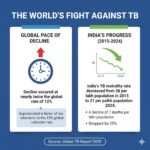Zero Shadow Day: Basics Explained

On August 18th as a rare natural occurrence known as “Zero Shadow Day” takes place.
During Zero Shadow Day(ZSD), a rare celestial phenomenon, vertical objects will be devoid of shadows for a brief period of time.
This celestial phenomenon occurs twice a year when the sun is directly overhead at its highest point in the sky and casts no shadow at all. This is due to the fact that the sun is exactly perpendicular to the surface of the earth, creating no shadow at all.
The ZSD is restricted to locations between the tropics(between the Tropic of Cancer and the Tropic of Capricorn). One falls during the Uttarayan when the Sun moves northwards, and the other is during Dakshinayan when the Sun moves southwards; this happens because happen because Earth’s rotation axis is tilted at an angle of roughly 23.5° to the axis of revolution around the Sun. The Sun’s location moves from 23.5°N to 23.5°S of Earth’s equator and back. All places whose latitude equals the angle between the Sun’s location and the equator on that day experience zero shadow day, with the shadow beneath an object at local noon.
LEARNING FROM HOME/ WITHOUT CLASSES/ BASICS
Axis is an imaginary line going right through the planet between the north and south poles. The axis is tilted somewhat off the plane of the earth’s revolution around the sun. The tilt of the axis is 23.5 degrees; thanks to this tilt, we enjoy the four seasons.
For several months of the year, one half of the earth receives more direct rays of the sun than the other half.
The equator is located at zero degrees latitude. The equator runs through Indonesia, Ecuador, northern Brazil, the Democratic Republic of the Congo, and Kenya, among other countries. It is 24,901.55 miles (40,075.16 kilometers) long. On the equator, the sun is directly overhead at noon on the two equinoxes – near March and September 21. The equator divides the planet into the Northern and Southern Hemispheres. On the equator, the length of day and night are equal every day of the year – day is always twelve hours long and night is always twelve hours long.
The Tropic of Cancer and the Tropic of Capricorn each lie at 23.5 degrees latitude. The Tropic of Cancer is located at 23.5° North of the equator and runs through Mexico, the Bahamas, Egypt, Saudi Arabia, India, and southern China. The Tropic of Capricorn lies at 23.5° South of the equator
and runs through Australia, Chile, southern Brazil (Brazil is the only
country that passes through both the equator and a tropic), and
northern South Africa.
Longitude is the angular distance of any point on Earth measured east or west of a point on Earth’s surface.
When looking at a map, latitude lines run horizontally. Latitude lines are also known as parallels since they are parallel and are an equal distant from each other. Each degree of latitude is approximately 69 miles (111 km) apart;. Degrees latitude are numbered from 0° to 90° north and south. Zero degree is the equator. 90° north is the North Pole and 90° south is the South Pole.







0 Comments